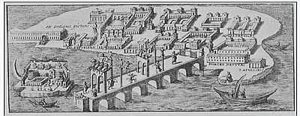 Drill core of volcanic ash-hydrated lime mortar from the ancient port of Baiae in Pozzuloi Bay. Inset is a scanning electron microscope image of the special Al-tobermorite crystals that are key to the superior quality of Roman seawater concrete.
Drill core of volcanic ash-hydrated lime mortar from the ancient port of Baiae in Pozzuloi Bay. Inset is a scanning electron microscope image of the special Al-tobermorite crystals that are key to the superior quality of Roman seawater concrete.
After 2000 years, a concrete breakwater built by the Romans has remained intact – despite being submerged in the warm, salt waters of the Mediterranean Sea for all that time. So why is it, with today’s modern technologies, that we have concrete structures eroding after merely a few short decades? How is it that the Romans could produce concrete of this superior quality?
Modern concrete is not always of inferior quality. Many factors contribute to premature deterioration, including improper waterproofing practices. An external, stick-on membrane, for instance, will be at the peak of its performance life that day it is applied, and will only deteriorate as time progresses. As these membranes weaken, seams between membrane sheets are more susceptible to water permeation, and the weakened membrane is no longer affective against hydrostatic pressure. This leads to water penetrating the concrete, quickly reaching the reinforcing rebar, and corroding the concrete structure from the inside out.
 Alternatively, using Krystol Internal Membrane (KIM) within the concrete itself helps the concrete become the barrier, by reacting with the water itself to create crystals which blocked the pores within the concrete, making them impervious to water. KIM, and other products using Krystol Technology will remain dormant throughout the life of the concrete, making the structure stronger and more resistant to water over time.
Alternatively, using Krystol Internal Membrane (KIM) within the concrete itself helps the concrete become the barrier, by reacting with the water itself to create crystals which blocked the pores within the concrete, making them impervious to water. KIM, and other products using Krystol Technology will remain dormant throughout the life of the concrete, making the structure stronger and more resistant to water over time.
Was this the Roman’s secret? Did they add something to their concrete that blocked the pores over the life of the structures? Although it was of a different composition, the concept was parallel to how the Krystol System works. The Romans made concrete by mixing lime and volcanic rock. For underwater structures, lime and volcanic ash were mixed to form mortar, and this mortar and volcanic tuff were packed into wooden forms. The seawater instantly triggered a hot chemical reaction. The lime was hydrated – incorporating water molecules into its structure – and reacted with the ash to cement the whole mixture together.
Using the lessons of the past can provide a foundation for creating better, more durable structures in the future, reducing environmental and financial costs incurred by concrete deterioration.







